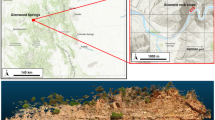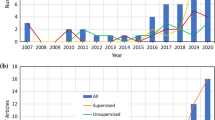Abstract
Three of the most well-known historical landslide areas in Western Greece were examined, concerning their temporal and kinematic evolution. Long-term ground displacements based on inclinometer data were analyzed. The aim of this study is to estimate the velocity trend type of movement through the years. The total time frame of kinematic evolution regarding the three currently studied landslide locations, was over 20 years for Panagopoula (1995–2017), 10 years for Karya (2005–2017), and 6 years for Platanos (2011–2017). All three landslides occur in soil or soft rock of Flysch and Neogene formations. In addition, two statistical approaches, time series decomposition, and autoregressive integrated moving average (ARIMA) method, were applied to identify the specific kinematic features as well as model movement evolution. In general, these techniques are used to improve forecasts as to better understand the time series characteristics. As a result, the movement evolution over time is substituted into a model that explains the behavior of the displacements time series. The models extracted from this analysis could overcome a common problem in long-term monitoring regarding measurement missing data due to technical matters or non-recorded periods.





Similar content being viewed by others
References
Alberti S, Crosta GB, Rivolta C (2017) Statistical analysis of displacement rate for definition of EW thresholds applied to two case studies. In: Mikoš M, Arbanas Ž, Yin Y, Sassa K (eds) Advancing culture of living with landslides WLF 2017. Springer, Cham. https://doi.org/10.1007/978-3-319-53487-9_32
Alevizakou EG, Pantazis GA (2017) Comparative evaluation of various models for prediction of displacements. Appl Geomat 9(2):93–103. https://doi.org/10.1007/s12518-017-0189-8
Ayalew L, Yamagishi H (2005) The application of GIS-based logistic regression for landslide susceptibility mapping in the Kakuda-Yahiko Mountains, Central Japan. Geomorphology 65:15–31. https://doi.org/10.1016/j.geomorph.2004.06.010
Bayer B, Simoni A, Mulas M, Corsini A, Schmidt D (2018) Deformation responses of slow moving landslides to seasonal rainfall in the Northern Apennines, measured by InSAR. Geomorphology 308:293–306. https://doi.org/10.1016/j.geomorph.2018.02.020
Bianchini S, Pratesi F, Nolesini T, Casagli N (2015) Building deformation assessment by means of persistent scatterer interferometry analysis on a landslide-affected area: the Volterra (Italy) case study. Remote Sens 7(4):4678–4701. https://doi.org/10.3390/rs70404678
Box GE, Jenkins GM (1976) Time series analysis, forecasting and control. Holden-Day, San Francisco
Calcaterra S, Cesi C, Di Maio C, Gambino P, Merli K, Vallario M, Vassallo R (2012) Surface displacements of two landslides evaluated by GPS and inclinometer systems: a case study in Southern Apennines. Ital Nat Haz 61(1):257–266
Calvello M, Peduto D, Arena L (2017) Combined use of statistical and DInSAR data analyses to define the state of activity of slow-moving landslides. Landslides 14(2):473–489. https://doi.org/10.1007/s10346-016-0722-6
Cascini L, Calvello M, Grimaldi GM (2014) Displacement trends of slow-moving landslides: classification and forecasting. J Mt Sci 11(3):592–606
Chung CJF, Fabbri AG (1999) Probabilistic prediction models for landslide hazard mapping. Photogramm Eng Remote Sens 65(12):1389–1399
Cimino G, Del Duce G, Kadonaga L, Rotundo G, Sisani A, Stabile G, Tirozzi B, Whiticar M (1999) Time series analysis of geological data. Chem Geol 161:253–270
Corominas J, van Westen C, Frattini P, Cascini L, Malet J-P, Fotopoulou S, Catani F, Van Den Eeckhaut M, Mavrouli O, Agliardi F, Pitilakis K, Winter MG, Pastor M, Ferlisi S, Tofani V, Hervás J, Smith JT (2014) Recommendations for the quantitative analysis of landslide risk. Bull Eng Geol Env 73(2):209–263. https://doi.org/10.1007/s10064-013-0538-8
Cruden DM, Varnes DJ (1996) Landslide types and processes. Spec Rep Natl Res Council Transp Res Board 247:36–75
De Vita P, Cusano D, La Barbera G (2017) Complex rainfall-driven kinematics of the slow-moving Pisciotta rock-slide (Cilento, Southern Italy). In: Mikoš M, Casagli N, Yin Y, Sassa K (eds) Advancing culture of living with landslides. WLF 2017. Springer, Cham. https://doi.org/10.1007/978-3-319-53485-5_64
Di Maio C, Vassallo R, Vallario M (2013) Plastic and viscous shear displacements of a deep and very slow landslide in stiff clay formation. Eng Geol 162:53–66
Fair RC (1986) Handbook of econometrics, Vol. 3, (eds). Z. Griliches and M.D. Intriligator, Elsevier Science Publishers BV, ch. 33.
Fell R, Corominas J, Bonnard C, Cascini L, Leroi E, Savage WZ, on behalf of the JTC-1 Joint Technical Committee on Landslides and Engineered Slopes (2008) Guidelines for landslide susceptibility, hazard and risk zoning for land use planning. Eng Geol 102:85–98. https://doi.org/10.1016/j.enggeo.2008.03.022
Feng G, Cobb S, Abdo Z, Fisher KD, Ouyang Y, Adeli A, Jenkins NJ (2016) Trend analysis and forecast of precipitation, reference evapotranspiration, and rainfall deficit in the Blackland Prairie of Eastern Mississippi. J Appl Meteorol Climatol 55(7):1425–1439. https://doi.org/10.1175/JAMC-D-15-0265.1
Gili JA, Corominas J, Rius J (2000) Using global positioning system techniques in landslide monitoring. Eng Geol 55(3):167–192. https://doi.org/10.1016/S0013-7952(99)00127-1
Glastonbury J, Fell R (2008) Geotechnical characteristics of large slow, very slow, and extremely slow landslides. Can Geotech J 45(7):984–1005
Gullà G, Calcaterra S, Gambino P, Borrelli L, Muto F (2018) Long-term measurements using an integrated monitoring network to identify homogeneous landslide sectors in a complex geo-environmental context (Lago Calabria, Italy). Landslides. https://doi.org/10.1007/s10346-018-0974-4
Guzzetti F, Carrara A, Cardinali M, Reichenbach P (1999) Landslide hazard evaluation: a review of current techniques and their application in a multi-scale study, Central Italy. Geomorphology 31:181–216
Handwerger AL, Roering JJ, Schmidt DA (2013) Controls on the seasonal deformation of slow-moving landslides. Earth Planet Sci Lett 377–378:239–247. https://doi.org/10.1016/j.epsl.2013.06.047
Hungr O, Corominas J, Eberhardt E (2005a) Estimating landslide motion mechanism, travel distance and velocity—state of the art report. In: Hungr O, Fell R, Couture R, Eberhardt E (eds) Landslide risk management. Balkema, Amsterdam, pp 99–128
Hungr O, Fell R, Couture R, Eberhardt E (2005b) Landslide risk management. Taylor and Francis, London, p 763
Iovine GGR, Lollino P, Gariano SL, Terranova OG (2010) Coupling limit equilibrium analyses and real-time monitoring to refine a landslide surveillance system in Calabria (southern Italy). Nat Hazard Earth Syst Sci 10(11):2341–2354. https://doi.org/10.5194/nhess-10-2341-2010
Jaboyedoff M, Oppikofer T, Abellán A, Derron MH, Loye A, Metzger R, Pedrazzini A (2012) Use of LIDAR in landslide investigations: a review. Nat Hazards 61(1):5–28. https://doi.org/10.1007/s11069-010-9634-2
Kaunda RB (2010) A linear regression framework for predicting subsurface geometries and displacement rates in deep-seated, slow-moving landslides. Eng Geol 114:1–9
Kavoura K, Anagnostopoulou S, Servou K, Depoundis N, Nikolakopoulos K, Sabatakakis N (2016a) Kinematic analysis evolution of extended landslides: two case studies from western Greece. Bull Geol Soc Greece 2:730–739
Kavoura K, Sabatakakis N, Tsiambaos G (2016b) Long term ground displacements due to a large landslide in western Greece. In: Aversa S, Cascini L, Picarelli L, Scavia C (eds) Landslides and engineered slopes. Experience, theory and practice. CRC Press, Boca Raton, pp 1177–1181
Kim BS, Hossein SZ, Choi G (2011) Evaluation of temporal-spatial precipitation variability and prediction using seasonal ARIMA model in Mongolia. KSCE J Civ Eng 15(5):917–925. https://doi.org/10.1007/s12205-011-1097-9
Koukis G, Sabatakakis N, Ferentinou M, Lainas S, Alexiadou X, Panagopoulos A (2009) Landslide phenomena related to major fault tectonics: rift zone of Corinth Gulf, Greece. Bull Eng Geol Environ 68:215–229. https://doi.org/10.1007/s10064-008-0184-8
Lainas S, Sabatakakis N, Koukis G (2016) Rainfall thresholds for possible landslide initiation in wildfire-affected areas of western Greece. Bull Eng Geol 75(3):883–896. https://doi.org/10.1007/s10064-015-0762-5
Macfarlane DF (2009) Observations and predictions of the behaviour of large, slow-moving landslides in schist, Clyde Dam reservoir. New Z Eng Geol 109(1–2):5–15
Malamud B, Turcotte D, Guzzetti F, Reichenbach P (2004) Landslide inventories and their statistical properties. Earth Surf Process Landforms 29:687–711
Massey CI, Petley DN, McSaveney MJ (2013) Patterns of movement in reactivated landslides. Eng Geol 159:1–19
Mavrouli OC, Corominas J, Jaboyedoff M (2015) Size distribution for potentially unstable rock masses and in situ rock blocks using LIDAR-generated digital elevation models. Rock Mech Rock Eng 48(4):1589–1604. https://doi.org/10.1007/s00603-014-0647-0
Nikolakopoulos GK, Kavoura K, Depountis N, Kyriou A, Argyropoulos N, Koukouvelas I, Sabatakakis N (2017) Preliminary results from active landslide monitoring using multidisciplinary surveys. Eur J Remote Sens 50(1):280–299. https://doi.org/10.1080/22797254.2017.1324741
Palenzuela JA, Jiménez-Perálvarez JD, El Hamdouni R, Alameda-Hernández P, Chacón J, Irigaray C (2015) Integration of LiDAR data for the assessment of activity in diachronic landslides: a case study in the Betic Cordillera (Spain). Landslides 13(4):629–642. https://doi.org/10.1007/s10346-015-0598-x
Peduto D, Ferlisi S, Nicodemo G, Reale D, Pisciotta G, Gullà G (2017) Empirical fragility and vulnerability curves for buildings exposed to slow-moving landslides at medium and large scales. Landslides 14(6):1993–2007. https://doi.org/10.1007/s10346-017-0826-7
Peduto D, Nicodemo G, Cuevas-Gonzáles M, Crosetto M (2019) Analysis of damage to buildings in urban centers on unstable slopes via TerraSAR-X PSI data: the case Study of El Papiol Town (Spain).IEEE Geoscience and Remote Sensing Letters, 16 (11), art. no. 8692420, pp. 1706–1710. DOI: 10.1109/LGRS.2019.2907557
Quan J, Zhan W, Chen Y, Wang M, Wang J (2016) Time series decomposition of remotely sensed land surface temperature and investigation of trends and seasonal variations in surface urban heat islands. J Geophys Res Atmos 121:2638–2657. https://doi.org/10.1002/2015JD024354
Sabatakakis N, Koukis G, Mourtas D (2005) Composite landslides induced by heavy rainfall in suburban areas: city of Patras and surrounding area, Western Greece. Landslides 2:202–211. https://doi.org/10.1007/s10346-005-0002-3
Sabatakakis N, Koukis G, Vassiliades E, Lainas S (2013) Landslide susceptibility zonation in Greece. Nat Hazards 65(1):523–543. https://doi.org/10.1007/s11069-012-0381-4
Sabatakakis N, Tsiambaos G, Rondoyanni T, Papanakli S, Kavoura K (2015) Deep-seated structurally controlled landslides of Corinth Gulf rift zone, Greece: the case of Panagopoula Landslide, 13th ISRM congress proceedings—Int’l Symposium on rock mechanics—innovations in applied and theoretical rock mechanics. ISBN: 978-1-926872-25-4, p 651, p 10
Shumway RH, Stoffer DS (2011) ARIMA models. In: Time series analysis and its applications. Springer texts in statistics. Springer, New York.
Simeoni L, Mongiovì L (2007) Inclinometer monitoring of the Castelrotto landslide in Italy. J Geotech Geoenviron Eng 133(6):653–666. https://doi.org/10.1061/(ASCE)1090-0241(2007)133:6(653)
Tsiambaos G, Sabatakakis N, Rondoyanni T, Depoundis N, Kavoura K (2015) Composite landslides affecting flysch and Neogene weak rock formations induced by heavy rainfalls. 13th ISRM Congress Proceedings - Int’l Symposium on Rock mechanics - innovations in applied and theoretical rock mechanics. ISBN: 978–1–926872–25–4, p656, 10p.
Van Asch WJ, Van Beek LPH, Bogaard TA (2007) Problems in predicting the mobility of slow-moving landslides. Eng Geol 91(1):46–55. https://doi.org/10.1016/j.enggeo.2006.12.012
Van Westen CJ (2004) Geo-information tools for landslide risk assessment: an overview of recent developments. In: Lacerda W, Erlich M, Fontoura SAB, Sayao ASF (eds) Landslides: evaluation and stabilization—glissement de terrain: evaluation et stabilisation. Balkema, London, pp 39–56
Weymer BA, Wernette P, Everett ME, Houser C (2018) Statistical modeling of the long-range-dependent structure of barrier island framework geology and surface geomorphology. Earth Surf Dyn 6(2):431–450. https://doi.org/10.5194/esurf-6-431-2018
WP, WLI (1995) International Geotechnical Societies’ UNESCO Working Party on World Landslide Inventory. Working Group on Rate of Movement (Chairman: Ch Bonnard) A suggested method for describing the rate of movement of a landslide. Bull Eng Geol Environ 52:75–78
Yürekli K, Simsek H, Cemek B, Karaman S (2007) Simulating climatic variables by using stochastic approach. Build Environ 42:3493–3499. https://doi.org/10.1016/j.buildenv.2006.10.046
Zhu Y, Wang Y, Liu T, Sui Q (2018) Assessing macroeconomic recovery after a natural hazard based on ARIMA—a case study of the 2008 Wenchuan earthquake in China. Nat Hazards 91(3):1025–1038. https://doi.org/10.1007/s11069-017-3163-1
Author information
Authors and Affiliations
Corresponding author
Additional information
Publisher's Note
Springer Nature remains neutral with regard to jurisdictional claims in published maps and institutional affiliations.
Rights and permissions
About this article
Cite this article
Kavoura, K., Konstantopoulou, M., Depountis, N. et al. Slow-moving landslides: kinematic analysis and movement evolution modeling. Environ Earth Sci 79, 130 (2020). https://doi.org/10.1007/s12665-020-8879-7
Received:
Accepted:
Published:
DOI: https://doi.org/10.1007/s12665-020-8879-7




